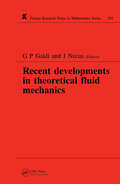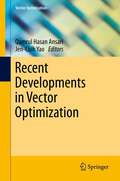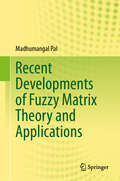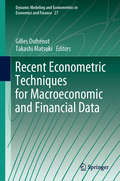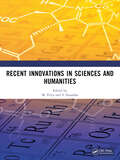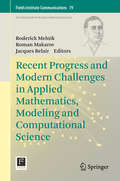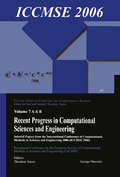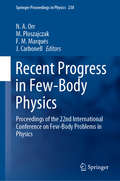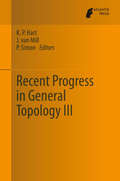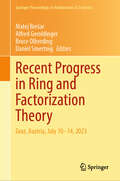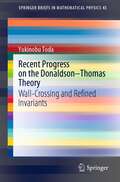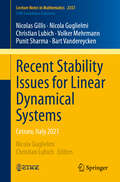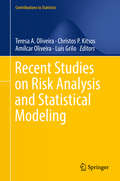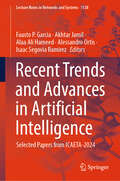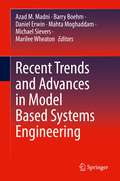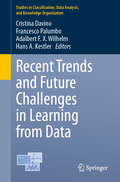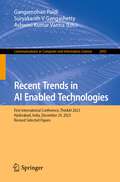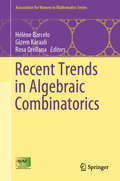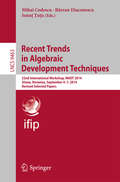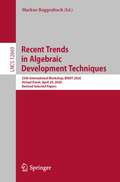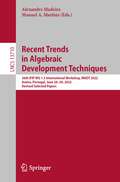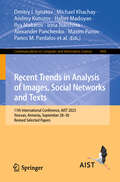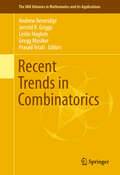- Table View
- List View
Recent Developments in Theoretical Fluid Mechanics: Winter School, Paseky, 1992
by J. Necas G P GaldiIncluding previously unpublished, original research material, this comprehensive book analyses topics of fundamental importance in theoretical fluid mechanics. The five papers appearing in this volume are centred around the mathematical theory of the Navier-Stokes equations (incompressible and compressible) and certain selected non-Newtonian modifications.
Recent Developments in Vector Optimization
by Qamrul Hasan Ansari Jen-Chih YaoWe always come cross several decision-making problems in our daily life. Such problems are always conflicting in which many different view points should be satisfied. In politics, business, industrial systems, management science, networks, etc. one often encounters such kind of problems. The most important and difficult part in such problems is the conflict between various objectives and goals. In these problems, one has to find the minimum(or maximum) for several objective functions. Such problems are called vector optimization problems (VOP),multi-criteria optimization problems or multi-objective optimization problems. This volume deals with several different topics / aspects of vector optimization theory ranging from the very beginning to the most recent one. It contains fourteen chapters written by different experts in the field of vector optimization.
Recent Developments of Fuzzy Matrix Theory and Applications
by Madhumangal PalThis book provides a comprehensive overview of the development of fuzzy matrix theory from its inception to its current state. It covers various types of fuzzy matrices, such as intuitionistic fuzzy matrices, interval-valued fuzzy matrices, interval-valued intuitionistic fuzzy matrices, bipolar fuzzy matrices, picture fuzzy matrices, neutrosophic fuzzy matrices, m-polar fuzzy matrices and similar one. Drawing primarily from the author's research work and collaborations, the book offers a state-of-the-art discussion of these topics. Theoretical concepts are illustrated with examples for clarity, accompanied by figures depicting fuzzy matrices and their variations. Suitable for both beginners and expert researchers, the book offers a wealth of material and includes numerous open problems at the end of almost all chapters to encourage further exploration and investigation.
Recent Econometric Techniques for Macroeconomic and Financial Data (Dynamic Modeling and Econometrics in Economics and Finance #27)
by Gilles Dufrénot Takashi MatsukiThe book provides a comprehensive overview of the latest econometric methods for studying the dynamics of macroeconomic and financial time series. It examines alternative methodological approaches and concepts, including quantile spectra and co-spectra, and explores topics such as non-linear and non-stationary behavior, stochastic volatility models, and the econometrics of commodity markets and globalization. Furthermore, it demonstrates the application of recent techniques in various fields: in the frequency domain, in the analysis of persistent dynamics, in the estimation of state space models and new classes of volatility models.The book is divided into two parts: The first part applies econometrics to the field of macroeconomics, discussing trend/cycle decomposition, growth analysis, monetary policy and international trade. The second part applies econometrics to a wide range of topics in financial economics, including price dynamics in equity, commodity and foreign exchange markets and portfolio analysis. The book is essential reading for scholars, students, and practitioners in government and financial institutions interested in applying recent econometric time series methods to financial and economic data.
Recent Innovations in Sciences and Humanities
by S. Anand M. Rishabha Priya V. Anandan H. Mary Henrietta S. VaralakshmiThe Conference covered a wide range of themes in various disciplines. In the field of English, the conference focused on digital tools in teaching and learning, the use of AI in language teaching and learning, literature in English language teaching, teacher training, and professional development, as well as linguistic competence in English language teachers.For those interested in mathematics, the conference explored topics such as computational methods for linear and non-linear optimization, mathematical models for computer science, numerical analysis, boundary value problems, real and complex analysis, probability and statistics, fluid dynamics, sequence spaces, mathematics education, applied mathematics, differential equations, and game theory.In the field of physics, the conference delved into materials science and engineering, functional materials, computational materials science, nanomaterials and nanotechnology, structural materials, photonic materials engineering, biomaterials, biomechanics, and biosensors.Lastly, in the field of chemistry, the conference discussed materials chemistry, composite, coating, and ceramic materials, soft matter and nanoscale materials, energy systems, and materials, functional thin-film materials, nanostructures and nanofilms, polymers and biopolymers, as well as surface science and engineering.
Recent Progress and Modern Challenges in Applied Mathematics, Modeling and Computational Science
by Roderick Melnik Roman Makarov Jacques BelairThis volume is an excellent resource for professionals in various areas of applications of mathematics, modeling, and computational science. It focuses on recent progress and modern challenges in these areas. The volume provides a balance between fundamental theoretical and applied developments, emphasizing the interdisciplinary nature of modern trends and detailing state-of-the-art achievements in Applied Mathematics, Modeling, and Computational Science. The chapters have been authored by international experts in their respective fields, making this book ideal for researchers in academia, practitioners, and graduate students. It can also serve as a reference in the diverse selected areas of applied mathematics, modelling, and computational sciences, and is ideal for interdisciplinary collaborations.
Recent Progress in Computational Sciences and Engineering (2 vols)
by Theodore SimosThis volume brings together selected contributed papers presented at the International Conference of Computational Methods in Science and Engineering (ICCMSE 2006), held in Chania, Greece, October 2006. The conference aims to bring together computational scientists from several disciplines in order to share methods and ideas. The ICCMSE is unique in its kind. It regroups original contributions from all fields of the traditional Sciences, Mathematics, Physics, Chemistry, Biology, Medicine and all branches of Engineering. It would be perhaps more appropriate to define the ICCMSE as a conference on computational science and its applications to science and engineering. Topics of general interest are: Computational Mathematics, Theoretical Physics and Theoretical Chemistry. Computational Engineering and Mechanics, Computational Biology and Medicine, Computational Geosciences and Meteorology, Computational Economics and Finance, Scientific Computation. High Performance Computing, Parallel and Distributed Computing, Visualization, Problem Solving Environments, Numerical Algorithms, Modelling and Simulation of Complex System, Web-based Simulation and Computing, Grid-based Simulation and Computing, Fuzzy Logic, Hybrid Computational Methods, Data Mining, Information Retrieval and Virtual Reality, Reliable Computing, Image Processing, Computational Science and Education etc. More than 800 extended abstracts have been submitted for consideration for presentation in ICCMSE 2005. From these 500 have been selected after international peer review by at least two independent reviewers.
Recent Progress in Few-Body Physics: Proceedings of the 22nd International Conference on Few-Body Problems in Physics (Springer Proceedings in Physics #238)
by N. A. Orr M. Ploszajczak F. M. Marqués J. CarbonellFew-body physics covers a rich and wide variety of phenomena, ranging from the very lowest energy scales of atomic and molecular physics to high-energy particle physics. The papers contained in the present volume provide an apercu of recent progress in the field from both the theoretical and experimental perspectives and are based on work presented at the “22nd International Conference on Few-Body Problems in Physics”.This book is geared towards academics and graduate students involved in the study of systems which present few-body characteristics and those interested in the related mathematical and computational techniques.
Recent Progress in General Topology III
by K. P. Hart J. Van Mill P. SimonThe book presents surveys describing recent developments in most of the primary subfields of General Topology, and its applications to Algebra and Analysis during the last decade, following the previous editions (North Holland, 1992 and 2002). The book was prepared in connection with the Prague Topological Symposium, held in 2011. During the last 10 years the focus in General Topology changed and therefore the selection of topics differs from that chosen in 2002. The following areas experienced significant developments: Fractals, Coarse Geometry/Topology, Dimension Theory, Set Theoretic Topology and Dynamical Systems.
Recent Progress in Ring and Factorization Theory: Graz, Austria, July 10–14, 2023 (Springer Proceedings in Mathematics & Statistics #477)
by Matej Brešar Alfred Geroldinger Bruce Olberding Daniel SmertnigThis proceedings volume gathers a selection of cutting-edge research in both commutative and non-commutative ring theory and factorization theory. The papers were presented at the Conference on Rings and Factorization held at the University of Graz, Austria, July 10–14, 2023. The volume covers a wide range of topics including multiplicative ideal theory, Dedekind, Prüfer, Krull, and Mori rings, non-commutative rings and algebras, rings of integer-valued polynomials, topological aspects in ring theory, factorization theory in rings and semigroups, and direct-sum decomposition of modules. The conference also featured two special sessions dedicated to Matej Brešar and Sophie Frisch on the occasion of their 60th birthdays. This volume is aimed at graduate students and researchers in these areas as well as related fields and provides new insights into both classical and contemporary research in ring and factorization theory.
Recent Progress in the Theory of the Euler and Navier-Stokes Equations
by James C. Robinson José L. Rodrigo Witold Sadowski Alejandro Vidal-LópezThe rigorous mathematical theory of the Navier–Stokes and Euler equations has been a focus of intense activity in recent years. This volume, the product of a workshop in Venice in 2013, consolidates, surveys and further advances the study of these canonical equations. It consists of a number of reviews and a selection of more traditional research articles on topics that include classical solutions to the 2D Euler equation, modal dependency for the 3D Navier–Stokes equation, zero viscosity Boussinesq equations, global regularity and finite-time singularities, well-posedness for the diffusive Burgers equations, and probabilistic aspects of the Navier–Stokes equation. The result is an accessible summary of a wide range of active research topics written by leaders in their field, together with some exciting new results. The book serves both as a helpful overview for graduate students new to the area and as a useful resource for more established researchers.
Recent Progress on Gravity Tests: Challenges and Future Perspectives (Springer Series in Astrophysics and Cosmology)
by Cosimo Bambi Alejandro Cárdenas-AvendañoEinstein's theory of general relativity is one of the pillars of modern physics and it is our standard framework for describing gravitational fields and the spacetime structure. So far, general relativity has passed all experimental tests and agrees with observations. However, the past few years have seen remarkable observational improvements and new techniques that continually challenge the theory's predictions: routinely detect the gravitational wave signals from the coalescence of black holes and neutron stars; can image the supermassive black holes at the center of our Galaxy and of the galaxy M87; can analyze the properties of the X-ray radiation emitted from the very inner part of the accretion disks of several black holes; and keep improving laboratory and Solar System experiments. This book offers an updated self-consistent overview, future perspectives, and challenges of experimental and observational tests of gravity, with both gravitational and electromagnetic spectra. It includes the recent results of laboratory tests of gravity, solar system experiments, tests of gravity in the strong-field regime with astrophysical compact objects, and tests of gravity on large scales with cosmological observations.
Recent Progress on the Donaldson–Thomas Theory: Wall-Crossing and Refined Invariants (SpringerBriefs in Mathematical Physics #43)
by Yukinobu TodaThis book is an exposition of recent progress on the Donaldson–Thomas (DT) theory. The DT invariant was introduced by R. Thomas in 1998 as a virtual counting of stable coherent sheaves on Calabi–Yau 3-folds. Later, it turned out that the DT invariants have many interesting properties and appear in several contexts such as the Gromov–Witten/Donaldson–Thomas conjecture on curve-counting theories, wall-crossing in derived categories with respect to Bridgeland stability conditions, BPS state counting in string theory, and others. Recently, a deeper structure of the moduli spaces of coherent sheaves on Calabi–Yau 3-folds was found through derived algebraic geometry. These moduli spaces admit shifted symplectic structures and the associated d-critical structures, which lead to refined versions of DT invariants such as cohomological DT invariants. The idea of cohomological DT invariants led to a mathematical definition of the Gopakumar–Vafa invariant, which was first proposed by Gopakumar–Vafa in 1998, but its precise mathematical definition has not been available until recently.This book surveys the recent progress on DT invariants and related topics, with a focus on applications to curve-counting theories.
Recent Stability Issues for Linear Dynamical Systems: Cetraro, Italy 2021 (Lecture Notes in Mathematics #2357)
by Nicola Guglielmi Volker Mehrmann Christian Lubich Nicolas Gillis Punit Sharma Bart VandereyckenThis book concerns matrix nearness problems in the framework of spectral optimization. It addresses some current research directions in spectral-based stability studies for differential equations, with material on ordinary differential equations (ODEs), differential algebraic equations and dynamical systems. Here, ‘stability’ is interpreted in a broad sense which covers the need to develop stable and reliable algorithms preserving some qualitative properties of the computed solutions, methodologies which are helpful to assess the onset of potential instabilities or loss of robustness, and tools to determine the asymptotic properties of the solution or its discretization. The topics considered include the computation of robustness measures for linear problems, the use of low-rank ODEs to approximate such measures via gradient systems, the regularity, stability, passivity and controllability analysis of structured linear descriptor systems, and the use of acceleration techniques to deal with some of the presented computational problems. Although the emphasis is on the numerical study of differential equations and dynamical systems, the book will also be of interest to researchers in matrix theory, spectral optimization and spectral graph theory, as well as in dynamical systems and systems theory.
Recent Studies on Risk Analysis and Statistical Modeling (Contributions to Statistics)
by Christos P. Kitsos Teresa A. Oliveira Amílcar Oliveira Luís GriloThis book provides an overview of the latest developments in the field of risk analysis (RA). Statistical methodologies have long-since been employed as crucial decision support tools in RA. Thus, in the context of this new century, characterized by a variety of daily risks - from security to health risks - the importance of exploring theoretical and applied issues connecting RA and statistical modeling (SM) is self-evident. In addition to discussing the latest methodological advances in these areas, the book explores applications in a broad range of settings, such as medicine, biology, insurance, pharmacology and agriculture, while also fostering applications in newly emerging areas. This book is intended for graduate students as well as quantitative researchers in the area of RA.
Recent Trends and Advances in Artificial Intelligence: Selected Papers from ICAETA-2024 (Lecture Notes in Networks and Systems #1138)
by Akhtar Jamil Alaa Ali Hameed Alessandro Ortis Isaac Segovia Ramirez Fausto P. GarciaThis book presents a curated selection of papers from the International Conference on Advanced Engineering, Technology, and Applications (ICAETA24), hosted by the University of Catania, Italy, in March 2024. The conference is co-organized by Istinye University, Turkey. The book delves into the forefront of technological advancements, spotlighting the latest trends and applications of artificial intelligence across diverse domains and addressing real-world challenges with transformative solutions. Readers will gain insights into state-of-the-art models and methodologies, particularly focusing on their applications on benchmark datasets. The discussions and presentations within this volume are organized around four pivotal tracks: Artificial Intelligence and Machine Learning, Big Data and Cloud Computing, Internet of Things and Sensor Technology, and Applications of Artificial Intelligence. Each track offers a deep dive into its respective domain, exploring the profound impact of technological innovations on various industries and sectors.
Recent Trends and Advances in Model Based Systems Engineering
by Azad M. Madni Barry Boehm Daniel Erwin Mahta Moghaddam Michael Sievers Marilee WheatonThis volume comprises papers from the 18th Conference on Systems Engineering Research (CSER). The theme of this volume, “Recent Trends and Advances in Model-Based Systems Engineering,” reflects the fact that systems engineering is undergoing a transformation motivated by mission and system complexity and enabled by technological advances such as model-based systems engineering, digital engineering, and the convergence of systems engineering with other disciplines. This conference is focused on exploring recent trends and advances in model-based systems engineering (MBSE) and the synergy of MBSE with simulation technology and digital engineering. Contributors have submitted papers on MBSE methods, modeling approaches, integration of digital engineering with MBSE, standards, modeling languages, ontologies and metamodels, and economics analysis of MBSE to respond to the challenges posed by 21st century systems. What distinguishes this volume are the latest advances in MBSE research, the convergence of MBSE with digital engineering, and recent advances in applied research in MBSE, including growing convergence with systems science and decision science. This volume is appropriate as a reference text in graduate engineering courses in Model-Based Systems Engineering.
Recent Trends and Future Challenges in Learning from Data (Studies in Classification, Data Analysis, and Knowledge Organization)
by Francesco Palumbo Cristina Davino Hans A. Kestler Adalbert F. X. WilhelmThis book collects together selected peer-reviewed contributions presented at the European Conference on Data Analysis, ECDA 2022, held in Naples, Italy, September 14-16, 2022. Highlighting the role of statistics in discovering novel and interesting patterns in the era of big data, it follows the motto of the conference: “Avoiding drowning in the data: recent trends and future challenges in learning from data”. The central focus is on multidisciplinary approaches to data analysis, classification, and the interface between computer science, data mining and statistics. Both methodological and applied topics are covered. The former includes supervised and unsupervised techniques with particular emphasis on advances in regression and clustering analysis and constructing composite indicators. The applications are mainly in risk analysis, biology, and education. The volume is organized into four main macro themes: methodological contributions in the social sciences and education, multivariate analysis methods for big data, innovative contributions for applications inspired by biology, and strategies for analyzing complex data in finance.
Recent Trends in AI Enabled Technologies: First International Conference, ThinkAI 2023, Hyderabad, India, December 29, 2023, Revised Selected Papers (Communications in Computer and Information Science #2045)
by Gangamohan Paidi Suryakanth V Gangashetty Ashwini Kumar VarmaThis book constitutes the refereed proceedings of the First International Conference on Recent Trends in AI Enabled Technologies, ThinkAI 2023, which took place in Hyderabad, India, in December 2023. The 7 full papers presented in these proceedings were carefully reviewed and selected from 51 submissions. The conference focuses on on up to date topics and recent trends in artificial intelligence and related technologies.
Recent Trends in Algebraic Combinatorics (Association for Women in Mathematics Series #16)
by Hélène Barcelo Gizem Karaali Rosa OrellanaThis edited volume features a curated selection of research in algebraic combinatorics that explores the boundaries of current knowledge in the field. Focusing on topics experiencing broad interest and rapid growth, invited contributors offer survey articles on representation theory, symmetric functions, invariant theory, and the combinatorics of Young tableaux. The volume also addresses subjects at the intersection of algebra, combinatorics, and geometry, including the study of polytopes, lattice points, hyperplane arrangements, crystal graphs, and Grassmannians. All surveys are written at an introductory level that emphasizes recent developments and open problems. An interactive tutorial on Schubert Calculus emphasizes the geometric and topological aspects of the topic and is suitable for combinatorialists as well as geometrically minded researchers seeking to gain familiarity with relevant combinatorial tools. Featured authors include prominent women in the field known for their exceptional writing of deep mathematics in an accessible manner. Each article in this volume was reviewed independently by two referees. The volume is suitable for graduate students and researchers interested in algebraic combinatorics.
Recent Trends in Algebraic Development Techniques: 22nd International Workshop (Lecture Notes in Computer Science #9463)
by Mihai Codescu Răzvan Diaconescu Ionuţ ŢuţuThis book constitutes the thoroughly refereedpost-conference proceedings of the 22nd International Workshop onAlgebraic Development Techniques, WADT 2014, held in September 2014 in Sinaia,Romania. The 8 revised papers presented were carefully reviewed and selected from 13presentations and focus together with one invited paper on foundations ofalgebraic specification, approaches to formal specification including processcalculi and models of concurrent, distributed and mobile computing,specification languages, methods, and environments, semantics of conceptualmodeling methods and techniques, model-driven development, graphtransformations, term rewriting and proof systems, integration of formalspecification techniques, formal testing and quality assurance, validation, andverification.
Recent Trends in Algebraic Development Techniques: 25th International Workshop, WADT 2020, Virtual Event, April 29, 2020, Revised Selected Papers (Lecture Notes in Computer Science #12669)
by Markus RoggenbachThis book constitutes the thoroughly refereed post-conference proceedings of the 25th International Workshop on Algebraic Development Techniques, WADT 2020, held virtually in April 2020.The 7 revised papers presented together with an invited paper were carefully reviewed and selected from 9 submissions. The contributed presentations covered a range of topics about the algebraic approach to system specification, which encompasses many aspects of the formal design of software systems. Originally born as formal method for reasoning about abstract data types, the algebraic approach now covers new specification frameworks and programming paradigms (such as object-oriented, aspect-oriented, agent-oriented, logic, and higher-order functional programming) as well as a wide range of application areas (including information systems, concurrent, distributed, and mobile systems).
Recent Trends in Algebraic Development Techniques: 26th IFIP WG 1.3 International Workshop, WADT 2022, Aveiro, Portugal, June 28–30, 2022, Revised Selected Papers (Lecture Notes in Computer Science #13710)
by Alexandre Madeira Manuel A. MartinsThis book constitutes the thoroughly refereed post-conference proceedings of the 26th International Workshop on Algebraic Development Techniques, WADT 2022, held in Aveiro, Portugal, in June 2022.The 6 revised papers presented together with 2 invited papers were carefully reviewed and selected from 25 submissions. The contributed presentations covered a range of topics about the algebraic approach to system specification, which encompasses many aspects of the formal design of software systems. Originally born as formal method for reasoning about abstract data types, the algebraic approach now covers new specification frameworks and programming paradigms (such as object-oriented, aspect-oriented, agent-oriented, logic, and higher-order functional programming) as well as a wide range of application areas (including information systems, concurrent, distributed, and mobile systems).
Recent Trends in Analysis of Images, Social Networks and Texts: 11th International Conference, AIST 2023, Yerevan, Armenia, September 28–30, Revised Selected Papers (Communications in Computer and Information Science #1905)
by Panos M. Pardalos Andrey V. Savchenko Dmitry I. Ignatov Alexander Panchenko Michael Khachay Andrey Kutuzov Elena Tutubalina Ilya Makarov Evgenii Tsymbalov Habet Madoyan Irina Nikishina Maxim Panov Sergey ZagoruykoThis book constitutes the refereed proceedings of the 11th International Conference on Recent Trends in Analysis of Images, Social Networks and Texts, AIST 2023, held in Yerevan, Armenia, during September 28–30, 2023. The 19 full papers 2 short papers and 1 demo paper included in this book were carefully reviewed and selected from 52 submissions. They were organized in topical sections as follows: Natural Language Processing; Computer Vision; Data Analysis and Machine Learning; Network Analysis; Theoretical Machine Learning and Optimization; and Demo Paper.
Recent Trends in Combinatorics
by Andrew Beveridge Jerrold R. Griggs Leslie Hogben Gregg Musiker Prasad TetaliThis volume presents some of the research topics discussed at the 2014-2015 Annual Thematic Program Discrete Structures: Analysis and Applications at the Institute for Mathematics and its Applications during Fall 2014, when combinatorics was the focus. Leading experts have written surveys of research problems, making state of the art results more conveniently and widely available. The three-part structure of the volume reflects the three workshops held during Fall 2014. In the first part, topics on extremal and probabilistic combinatorics are presented; part two focuses on additive and analytic combinatorics; and part three presents topics in geometric and enumerative combinatorics. This book will be of use to those who research combinatorics directly or apply combinatorial methods to other fields.
